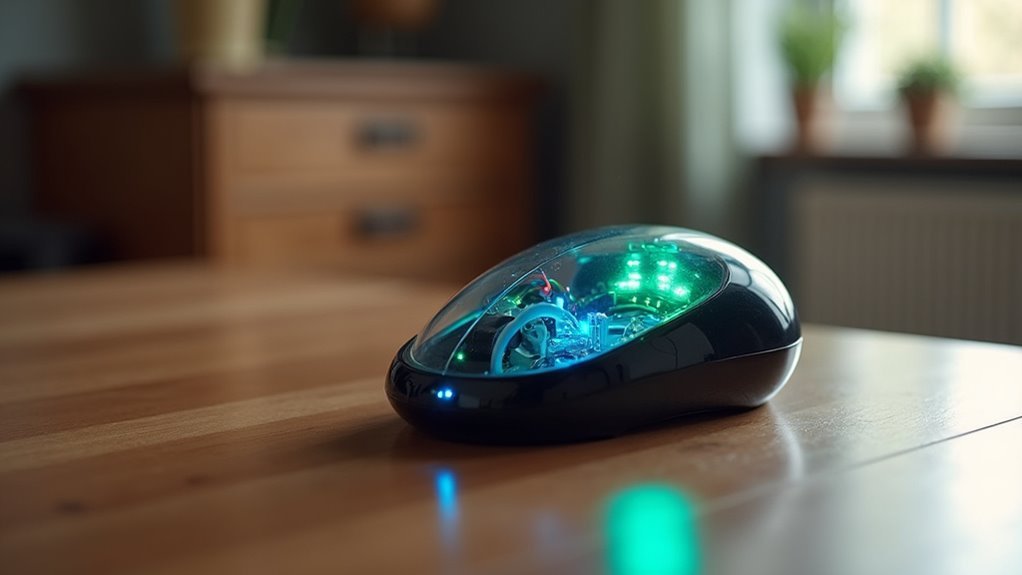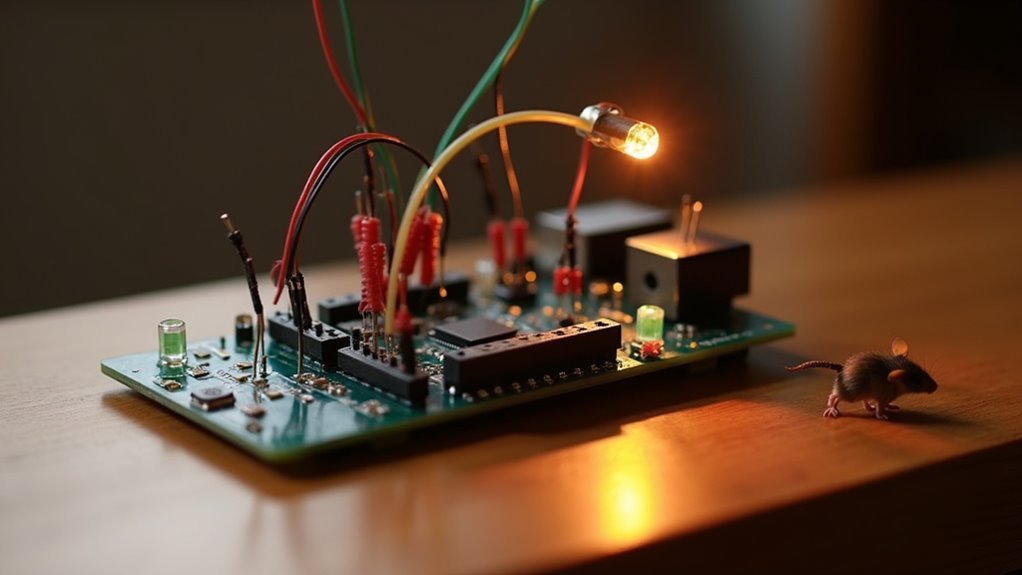You can build five effective silent mouse detectors using common components: a motion-activated LED circuit with PIR sensors that lights up when mice enter detection zones, an ultrasonic sensor system that emits inaudible frequencies to monitor movement patterns, an infrared beam break detector using LED and photodiode barriers, pressure-sensitive floor pads with force-sensitive resistors, and Arduino-powered smart sensors that send smartphone notifications. These DIY solutions offer chemical-free pest monitoring with detailed instructions ahead.
Motion-Activated LED Circuit Mouse Detector

One effective approach to silent mouse detection involves building a motion-activated LED circuit that uses a passive infrared (PIR) sensor to monitor rodent activity.
A simple PIR sensor circuit with LED indicator provides an efficient, silent method for detecting and tracking mouse movements.
You’ll need a 9V battery, PIR sensor, LED, and current-limiting resistor for safe operation. When a mouse enters the sensor’s detection zone, it triggers a high signal that activates the LED for a predetermined duration before automatically shutting off.
This detector works excellently in homes or gardens where you need to track rodent movement patterns. You don’t need extensive electronic knowledge to build this circuit, making it perfect for hobbyists.
Make sure you incorporate a protective housing unit to shield components from environmental factors. This weatherproofing considerably enhances your detector’s longevity and maintains consistent performance throughout extended monitoring periods.
Ultrasonic Sensor-Based Rodent Movement Monitor
Building beyond visual detection methods, ultrasonic sensors offer a sophisticated approach to monitoring rodent movement through high-frequency sound waves.
You’ll emit inaudible frequencies between 20-40 kHz that bounce off objects and return to the sensor, measuring travel time to detect movement within 3-6 meters.
You can integrate these sensors into monitoring systems that trigger alerts or record data when rodents enter their range. The system distinguishes between human presence and rodent activity by analyzing size and movement patterns, reducing false alarms.
You’ll achieve better accuracy by deploying multiple sensors to cover larger areas and minimize false positives from non-target animals.
This cost-effective, non-intrusive solution provides indoor pest control without relying on traps or poisons.
Infrared Beam Break Detection System

While ultrasonic sensors rely on sound wave reflections, infrared beam break detection systems create invisible light barriers that trigger alerts when rodents interrupt the beam path. You’ll position an infrared LED on one side and a photodiode on the opposite side to establish this barrier. When mice pass through, they block the infrared light, causing the photodiode to detect the interruption and trigger your alert system.
| Component | Function |
|---|---|
| Infrared LED | Emits invisible light beam |
| Photodiode | Receives and detects infrared light |
| Circuit Board | Processes detection signals |
| Power Source | Provides system energy |
| Alert Mechanism | Activates upon beam interruption |
You can customize the detection range by adjusting the distance between components. These systems offer quick response times and work reliably in low-light conditions, making them perfect for silent mouse monitoring applications.
Pressure-Sensitive Floor Pad Alert Device
Pressure-sensitive floor pad alert devices transform ordinary surfaces into smart detection zones that silently monitor rodent movement through weight-activated sensors.
You’ll place force-sensitive resistors (FSRs) beneath strategic floor areas where mice typically travel. When rodents step on these pads, the sensors detect weight changes and send signals to your connected microcontroller.
You can customize pad size and sensitivity based on your specific rodent detection needs. The microcontroller processes sensor input and triggers silent alerts like LED lights or vibrations.
For enhanced functionality, you’ll integrate wireless technology that sends notifications directly to your smartphone without producing any sound that might startle mice.
This system works exceptionally well in narrow pathways, under cabinets, or near food sources where mice frequently travel, providing reliable detection without noise.
Arduino-Powered Smart Trap Activity Sensor

Arduino microcontrollers elevate silent mouse detection by transforming traditional traps into intelligent monitoring systems that track rodent activity in real-time.
You’ll use passive infrared (PIR) sensors to detect movement, automatically triggering alerts when mice enter your designated areas. The Arduino sends instant notifications to your smartphone, ensuring you won’t miss any activity.
You can customize sensitivity levels and program the device to activate traps automatically when motion’s detected.
Adding camera modules provides visual confirmation of captures, while ultrasonic deterrents discourage pests from approaching.
The system logs data over time, helping you identify patterns in rodent behavior and optimize your pest control strategy.
This programmable solution offers precise monitoring without disturbing household activities.
Frequently Asked Questions
What Mouse Doesn T Make a Click Sound?
You’ll want silent mice like the Logitech M330 or M220, which use rubber dome switches or optical sensors instead of traditional mechanical clicks, reducing noise by up to 90% for quiet operation.
What Is the Best Pixart Sensor for a Mouse?
You’ll want the PMW3360 for exceptional gaming performance, offering 12,000 DPI and outstanding tracking accuracy. It’s widely considered the gold standard among PixArt sensors for competitive gaming mice.
What Is the Super Quiet Logitech Mouse?
You’ll want the Logitech M330 Silent Plus, which reduces noise by 90% compared to traditional mice. It’s designed specifically for quiet environments with silent clicks and rubber grip comfort.
In Summary
You’ve now got five effective silent mouse detection methods at your disposal. Whether you choose the simple LED circuit or the advanced Arduino sensor, you’ll catch rodent activity without disturbing your household. Each detector offers unique advantages – from the ultrasonic monitor’s wide coverage to the pressure pad’s precise triggering. Pick the option that matches your technical skills and detection needs, then start building your silent surveillance system.





Leave a Reply